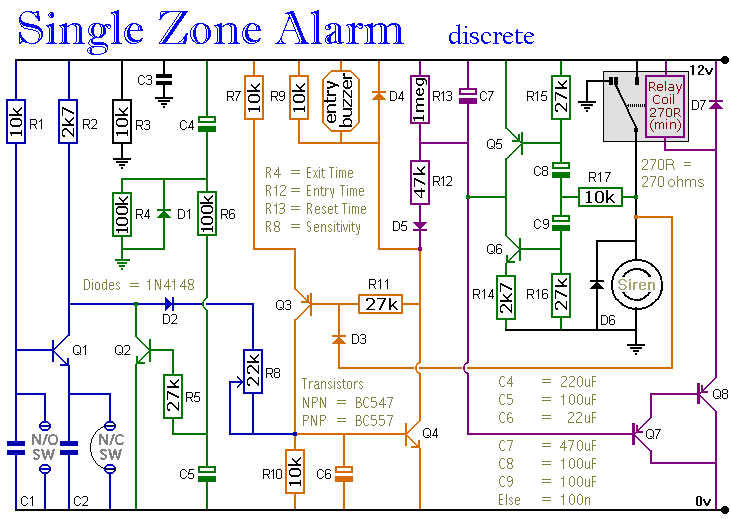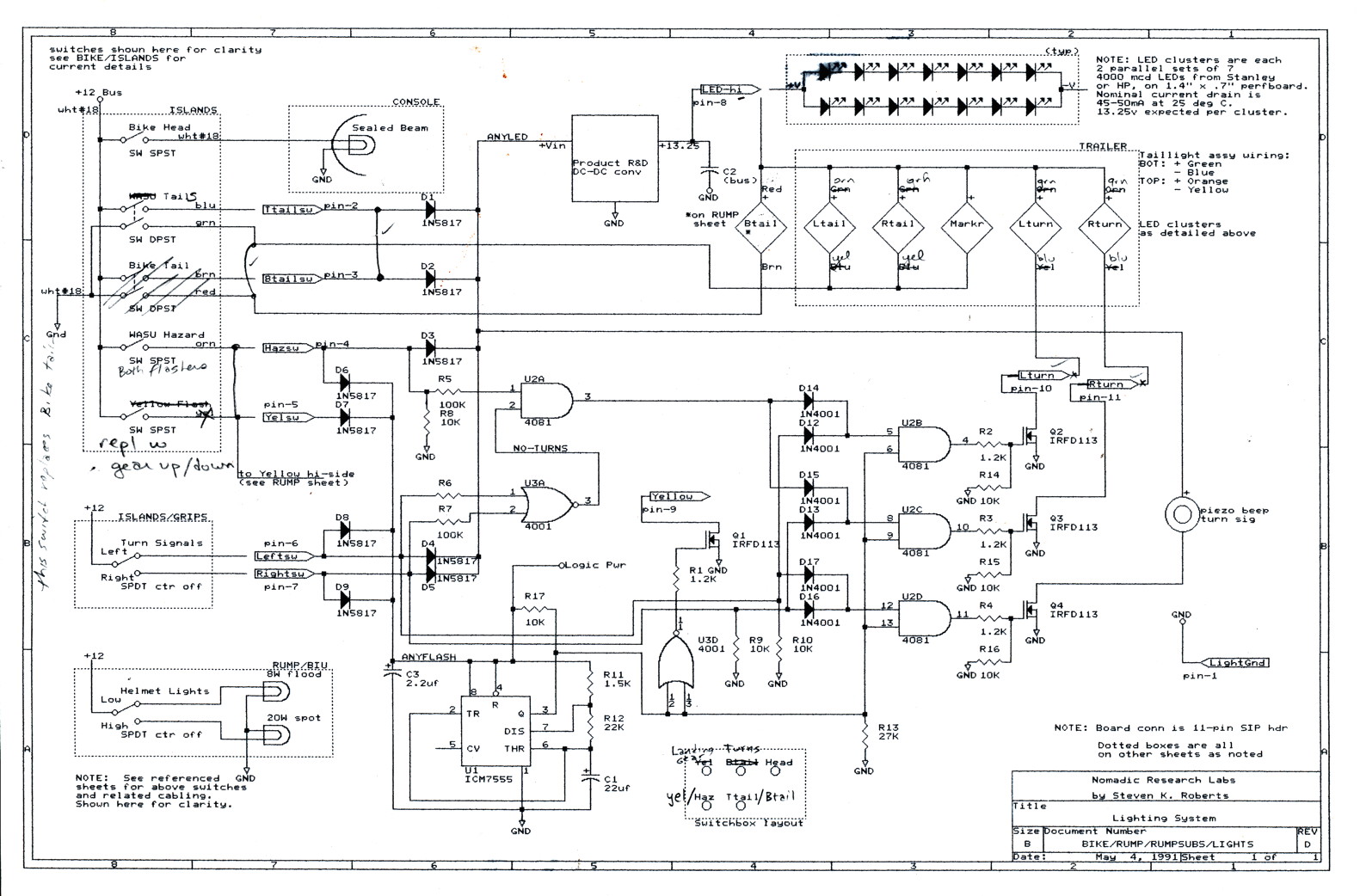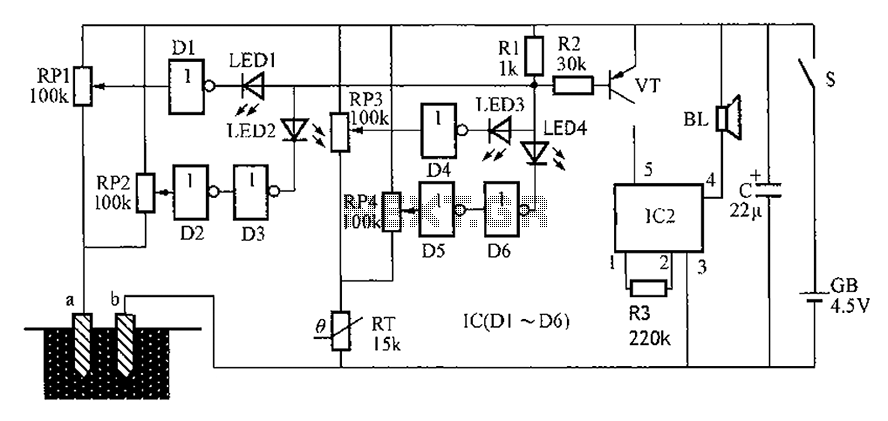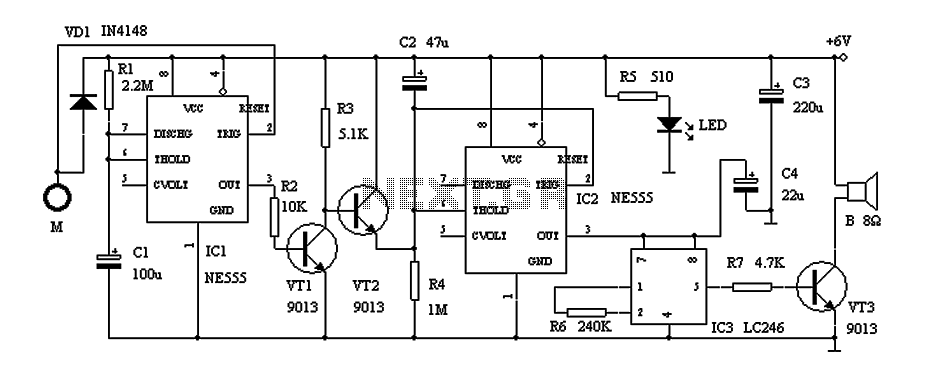
sun up alarm schematics
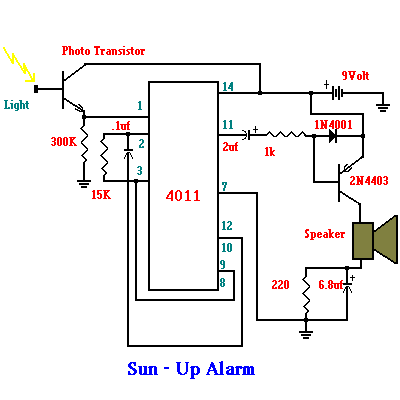
The Up Alarm is designed to provide an audible alert when sunlight is detected or when a light source is activated in a dark environment. It can also be utilized to sense various light sources such as beams or headlights. The operation of the circuit is based on a phototransistor, which is highly sensitive to light. When sunlight strikes the phototransistor, it generates a high signal to one of the NAND gates. This activation causes another NAND gate to oscillate, producing a 100 Hz tone through a connected speaker, with the transistor supplying the necessary drive for the speaker.
The Up Alarm circuit integrates a phototransistor as the primary light-sensing component. The phototransistor operates by converting light energy into an electrical signal. When exposed to light, such as sunlight or artificial illumination, the phototransistor conducts, allowing current to flow through the circuit. This change in current is detected by a NAND gate, which is configured to respond to the high signal generated by the phototransistor.
The first NAND gate in the circuit acts as a light detector. Upon receiving a high signal from the phototransistor, it outputs a low signal to the second NAND gate. This second gate is configured in such a way that it oscillates when it receives a low signal from the first gate. The oscillation frequency is determined by external components, typically resistors and capacitors, connected to the second NAND gate, which in this case is set to generate a 100 Hz tone.
The output from the second NAND gate is then fed into a transistor that functions as a driver for the speaker. The transistor amplifies the oscillating signal, allowing it to drive the speaker effectively. The speaker converts the electrical signal into sound, producing an audible alarm that alerts users to the presence of light.
This circuit can be applied in various scenarios, such as outdoor alarms that activate at sunrise or indoor applications where light detection is necessary. The versatility of the Up Alarm circuit makes it suitable for a range of environments, providing both functionality and simplicity in design. Proper selection of the phototransistor and tuning of the oscillation frequency can enhance the sensitivity and performance of the alarm system.Up Alarm can be used to provide a audible alarm for when the sun comes up or it can be used in a dark area and detect when a light comes on. It can also be used to detect a light b eam, headlights etc. The circuit works as follows. The phototransistor is very sensitive to light. (Any phototransistor will work fine) The sun shining on this device will provide a high to one of the NAND gates. This will cause another NAND gate to oscillate which will drive another gate to output a 100hz tone. The transistor provides drive for the speaker. 🔗 External reference
The Up Alarm circuit integrates a phototransistor as the primary light-sensing component. The phototransistor operates by converting light energy into an electrical signal. When exposed to light, such as sunlight or artificial illumination, the phototransistor conducts, allowing current to flow through the circuit. This change in current is detected by a NAND gate, which is configured to respond to the high signal generated by the phototransistor.
The first NAND gate in the circuit acts as a light detector. Upon receiving a high signal from the phototransistor, it outputs a low signal to the second NAND gate. This second gate is configured in such a way that it oscillates when it receives a low signal from the first gate. The oscillation frequency is determined by external components, typically resistors and capacitors, connected to the second NAND gate, which in this case is set to generate a 100 Hz tone.
The output from the second NAND gate is then fed into a transistor that functions as a driver for the speaker. The transistor amplifies the oscillating signal, allowing it to drive the speaker effectively. The speaker converts the electrical signal into sound, producing an audible alarm that alerts users to the presence of light.
This circuit can be applied in various scenarios, such as outdoor alarms that activate at sunrise or indoor applications where light detection is necessary. The versatility of the Up Alarm circuit makes it suitable for a range of environments, providing both functionality and simplicity in design. Proper selection of the phototransistor and tuning of the oscillation frequency can enhance the sensitivity and performance of the alarm system.Up Alarm can be used to provide a audible alarm for when the sun comes up or it can be used in a dark area and detect when a light comes on. It can also be used to detect a light b eam, headlights etc. The circuit works as follows. The phototransistor is very sensitive to light. (Any phototransistor will work fine) The sun shining on this device will provide a high to one of the NAND gates. This will cause another NAND gate to oscillate which will drive another gate to output a 100hz tone. The transistor provides drive for the speaker. 🔗 External reference
Warning: include(partials/cookie-banner.php): Failed to open stream: Permission denied in /var/www/html/nextgr/view-circuit.php on line 713
Warning: include(): Failed opening 'partials/cookie-banner.php' for inclusion (include_path='.:/usr/share/php') in /var/www/html/nextgr/view-circuit.php on line 713
